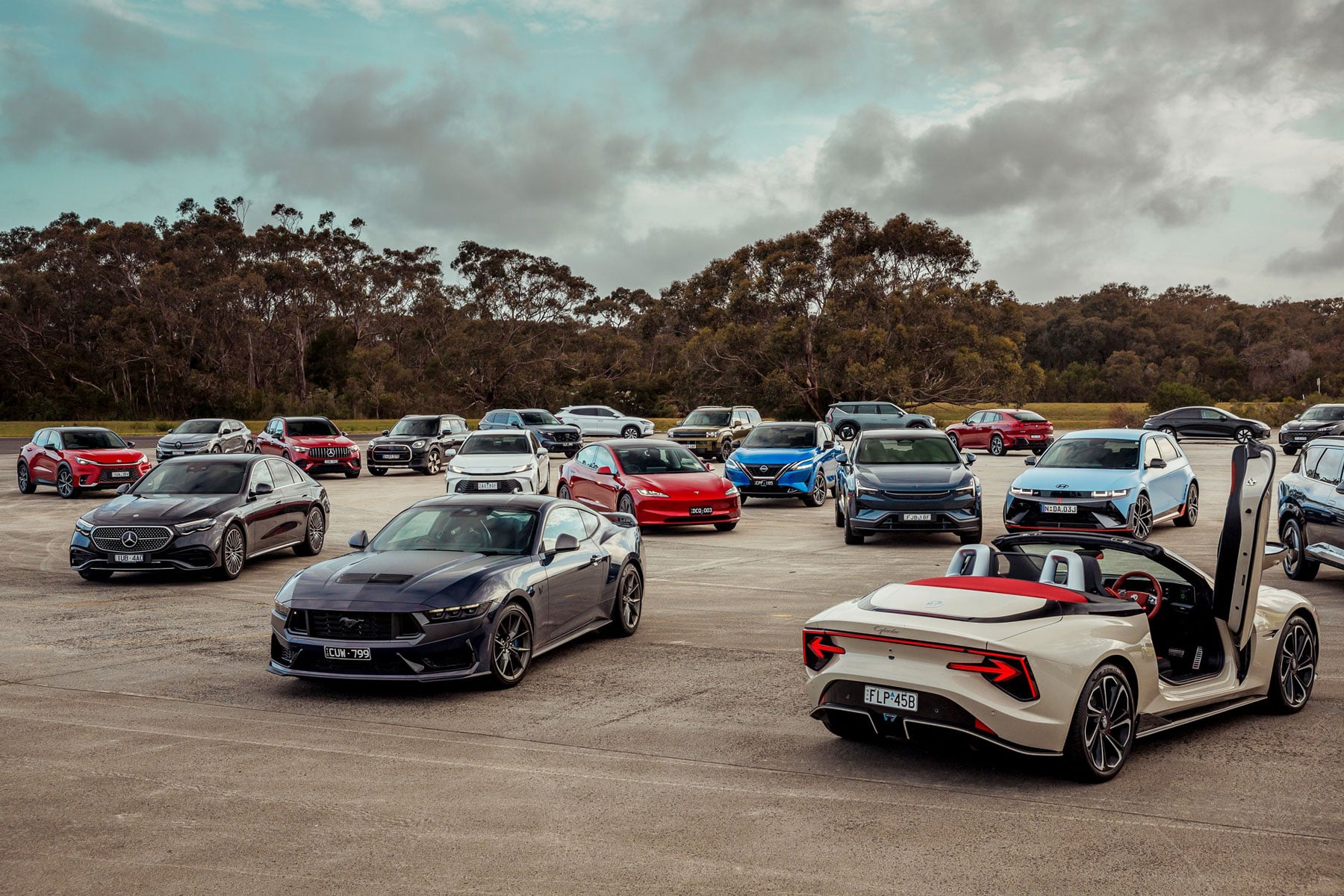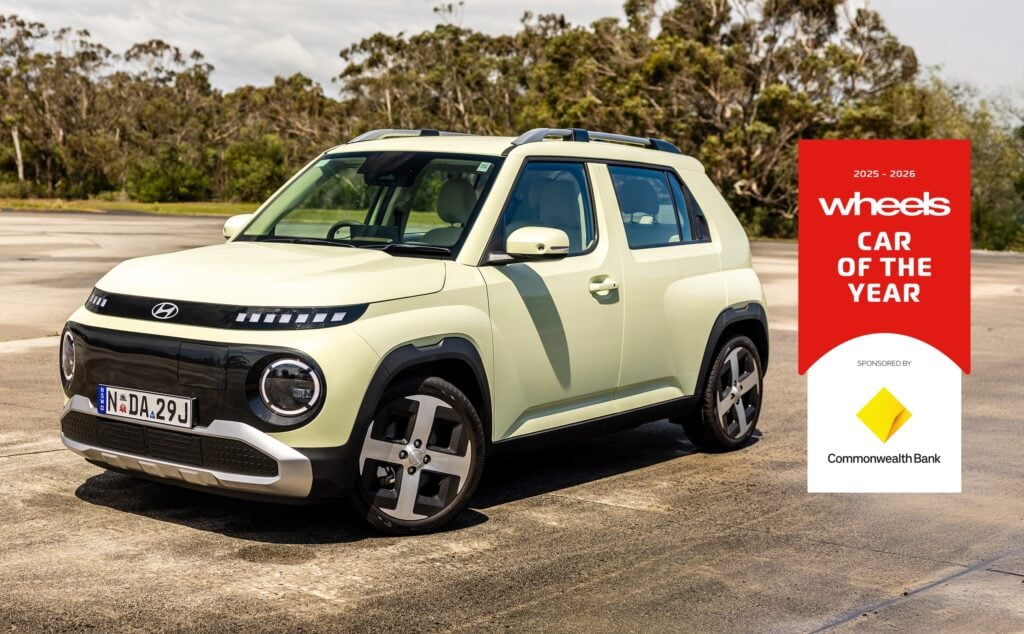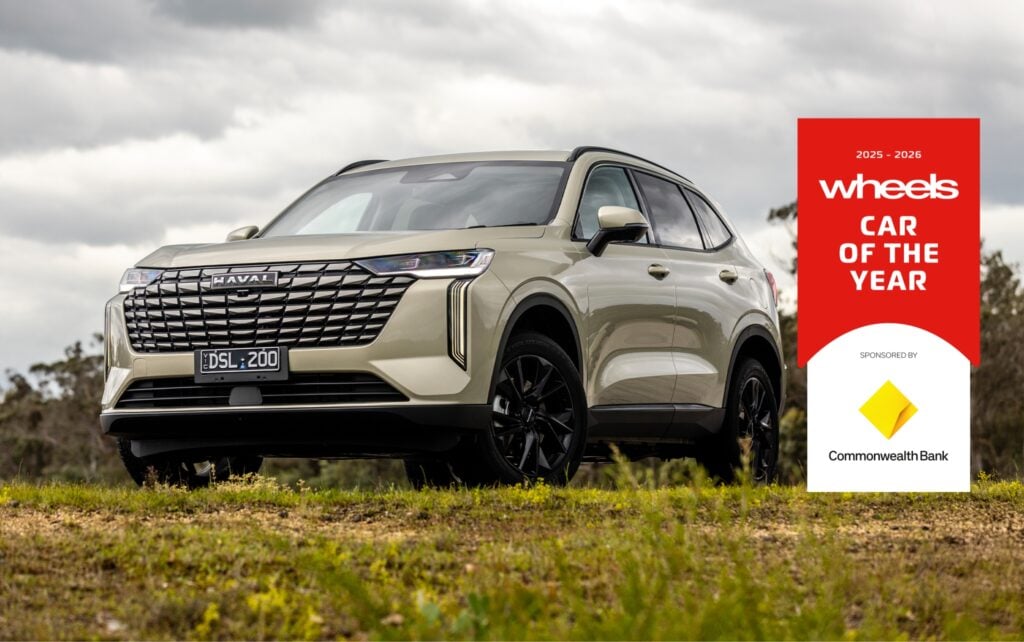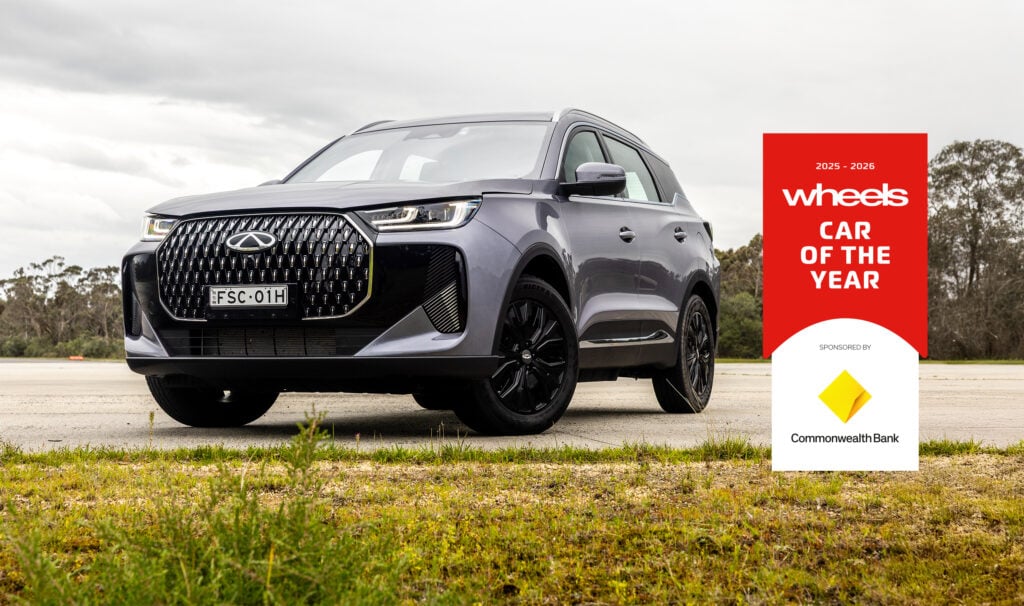Ford Mustang Dark Horse
The new S650 Dark Horse aims to show that the Mustang’s old days of the slightly unresolved and unsophisticated muscle car are behind it.
You might be wondering how a Ford that costs $105,332 as tested could possibly be considered good value. Especially when the Dark Horse doesn’t seem to be that different to the regular Mustang GT upon which it’s based, despite costing $22,000 more. And yet it only takes about 10 metres to realise the Dark Horse is unlike any Mustang we’ve ever driven.
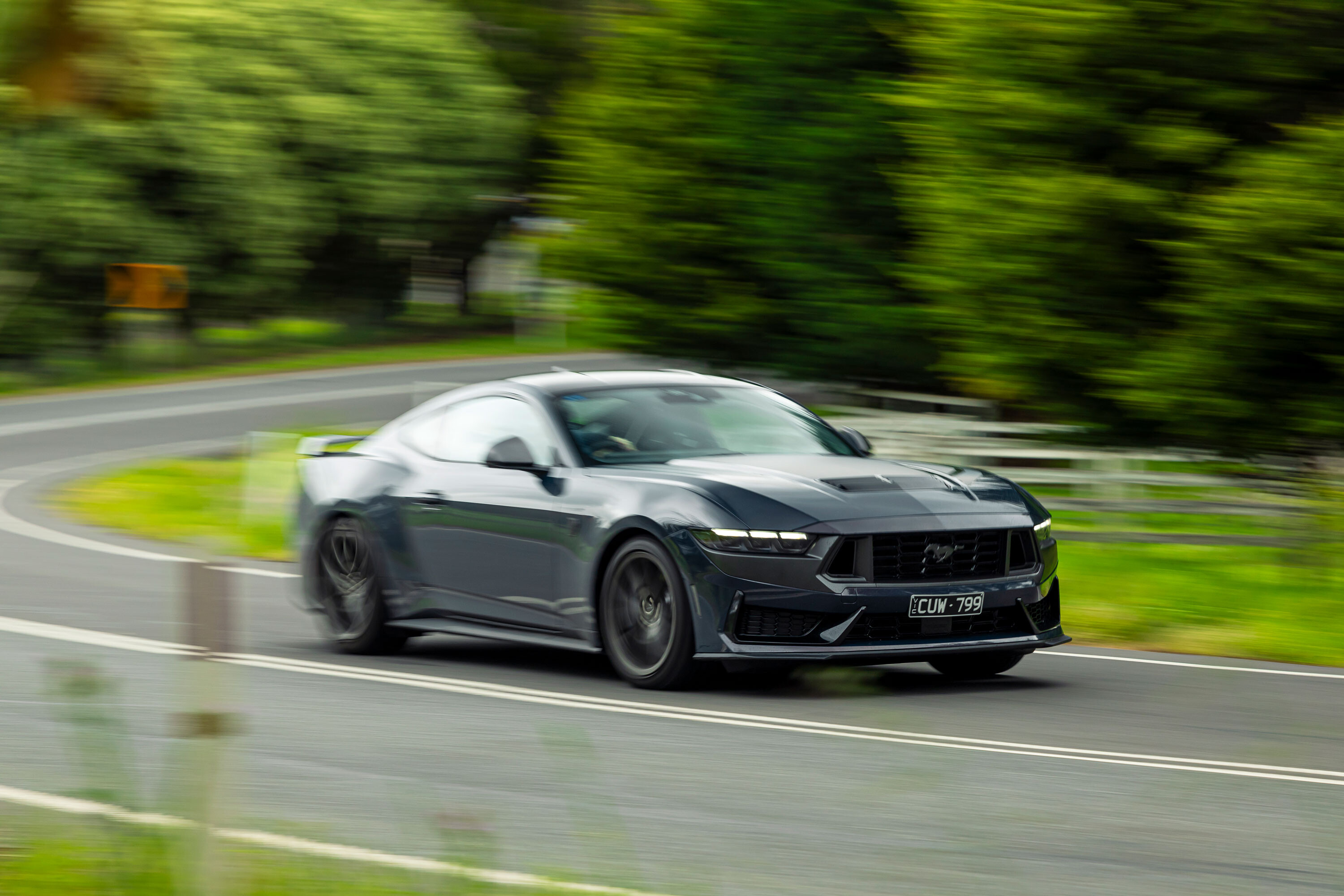
It starts with the steering. The Dark Horse scores a different calibration and rides on overhauled suspension compared with the GT for a tauter, more track-focused set-up, and as soon as you crank on some lock you know you’re dealing with something special. There isn’t much feel per se, but there’s none of the usual Mustang wooliness either, and around Lang Lang’s tricky mix of low- and high-speed corners, the Dark Horse is a riot.
Fast, loud and with an athleticism that belies its nameplate and 1822kg kerb weight, the Dark Horse delivers a driving experience that is surprisingly involving and rewarding. A big part of that is down to the gearbox. You can have the Dark Horse as a 10-speed automatic but our car is the six-speed manual (remember those?) and it is without question the better pick. The manual ’box is different to other V8 Mustangs, with Ford ditching the GT’s Getrag MT82-D4 in favour of the same Tremec TR-3160 unit that’s fitted to the Shelby GT350.It brings shorter ratios, a revised final drive and, crucially, a more positive shift action.
With 350kW/550Nm on tap, the Dark Horse shares the core of its naturally aspirated 5.0-litre V8 with the regular GT but it gains additional cooling and uses connecting rods taken from the Shelby GT500. It also scores an active exhaust with five modes, ranging from quiet to racetrack, and it sounds brilliant. Deep and menacing at idle, it also has enough light and shade as you rise through the rev range to sound properly exciting.
Combine all this with a surprising litheness through the lane-change manoeuvre and an impressive ability to soak up Lang Lang’s lumps, bumps and surface changes (unique springs and MagneRide adaptive dampers are standard inclusions) and it’s little wonder the Dark Horse breezed through the first round of voting to become a finalist.
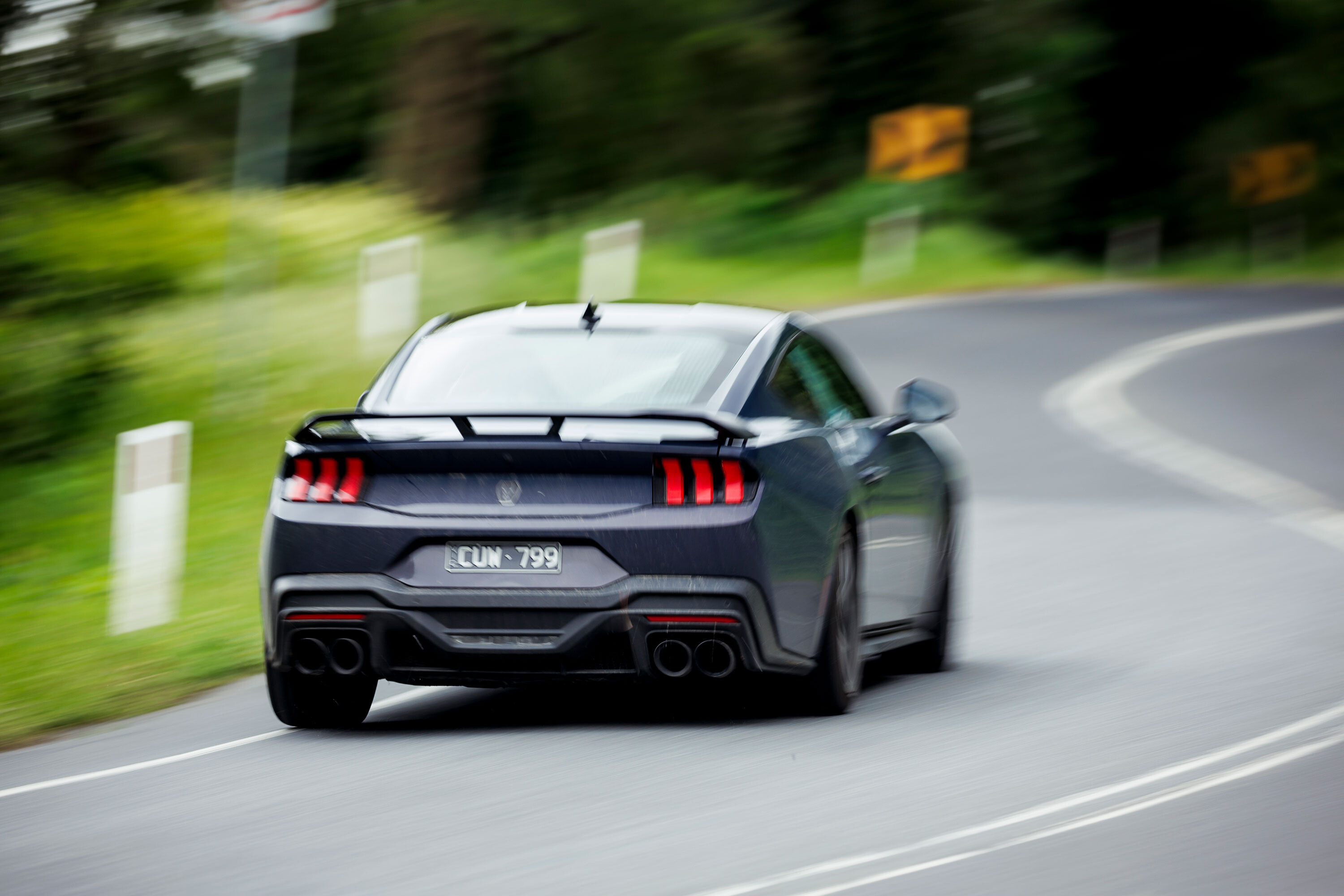
Amazingly, though, the Dark Horse is even more impressive on COTY’s road loop. Poise isn’t a word you’d usually associate with a Mustang but over our road course’s challenging mix of broken back roads, that’s exactly what the Dark Horse delivers. Given its track focus and wider wheel and tyre package compared with the GT, you could forgive the Dark Horse for feeling overly stiff but the compliance and control delivered by the tweaked suspension and MagneRide dampers is surprising. Grip and traction are strong, and instead of being upset by mid-corner bumps or skipping wide in traction zones, the Dark Horse offers a sense of connection, confidence and speed that suggests it’s a better road car than it is a track-day machine.
It’s certainly comfortable enough to use everyday. The ride has a pleasing duality and the cabin, which has long been a Mustang weakness, is a welcome improvement thanks to better quality materials and a new dual-screen digital dash. The dash which includes a nerdy level of performance data and the ability to cycle through design themes for the instruments which can replicate the look and feel of previous hero Mustangs like the original ’60s model, an ’80s Fox Body and, my personal favourite, the white dials of an SVT Cobra.
As it stands, the Dark Horse is a remarkable machine – certainly one that delivers a driving experience that is more than the sum of its parts.
– Alex Inwood
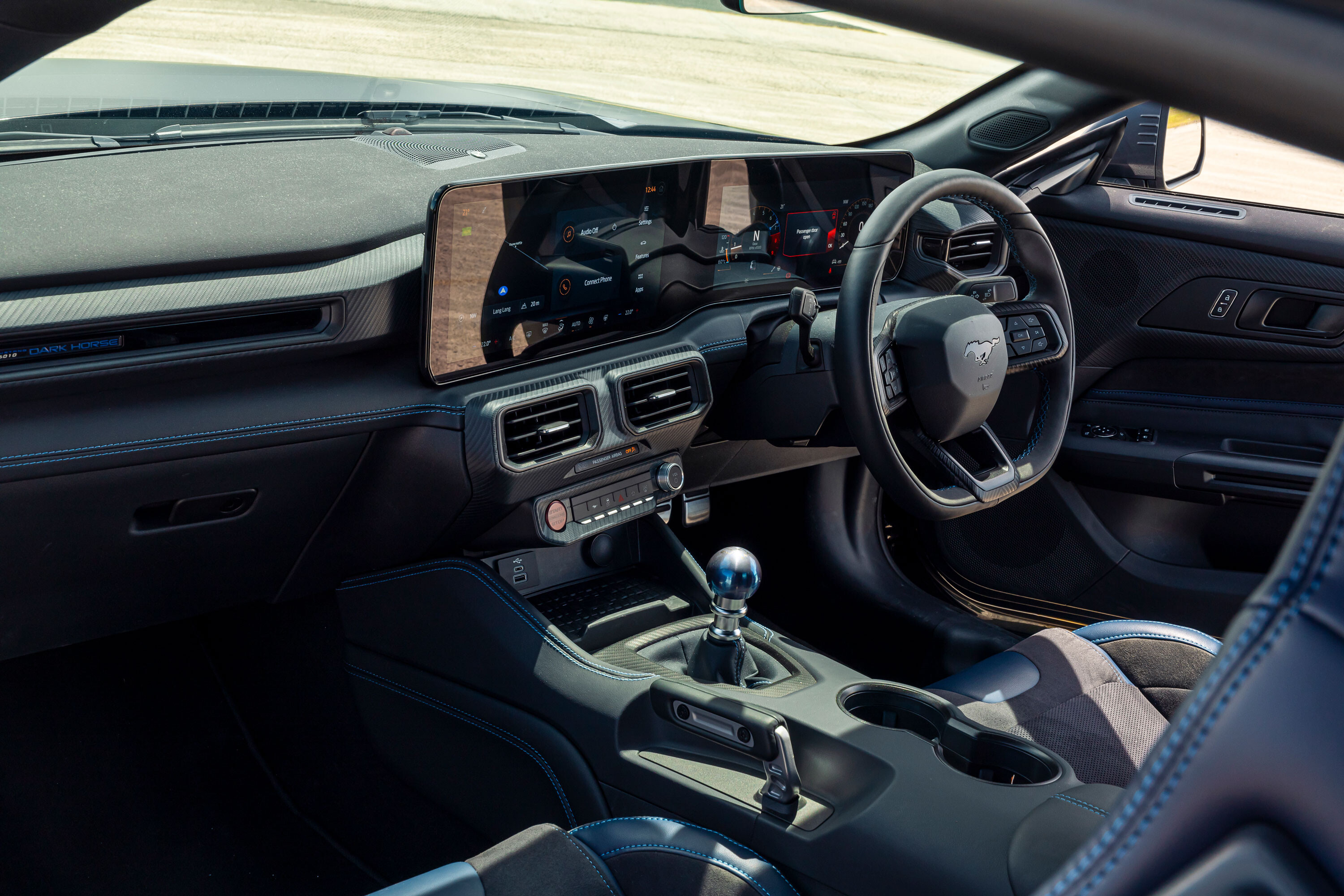
| Ford Mustang Dark Horse | |
|---|---|
| Price/as tested | $99,102/$105,332 |
| Drive | 5.0-litre V8, dohc, 32v |
| Power | 350kW @ 7250rpm |
| Torque | 550Nm @ 4850rpm |
| Transmission | 6-sp manual/10-sp auto |
| Weight | 1822kg (m), 1842kg (a) |
| L/W/H/WB | 4823/2097/1413/2719mm |
| Tyre | Pirelli P Zero 255/40R19 (f), 275/40R19 (r) |
| Safety | Untested |
Hyundai Santa Fe Calligraphy
It’s ironic that Hyundai’s out-of-the-box design theme for the fifth-generation Santa Fe large SUV resembles a box on wheels. This eye-catching aesthetic, which is repeated outside and in, is designed to be exactly that. Hyundai wants the Santa Fe to be noticed because the previous four generations were too often overlooked by car shoppers.
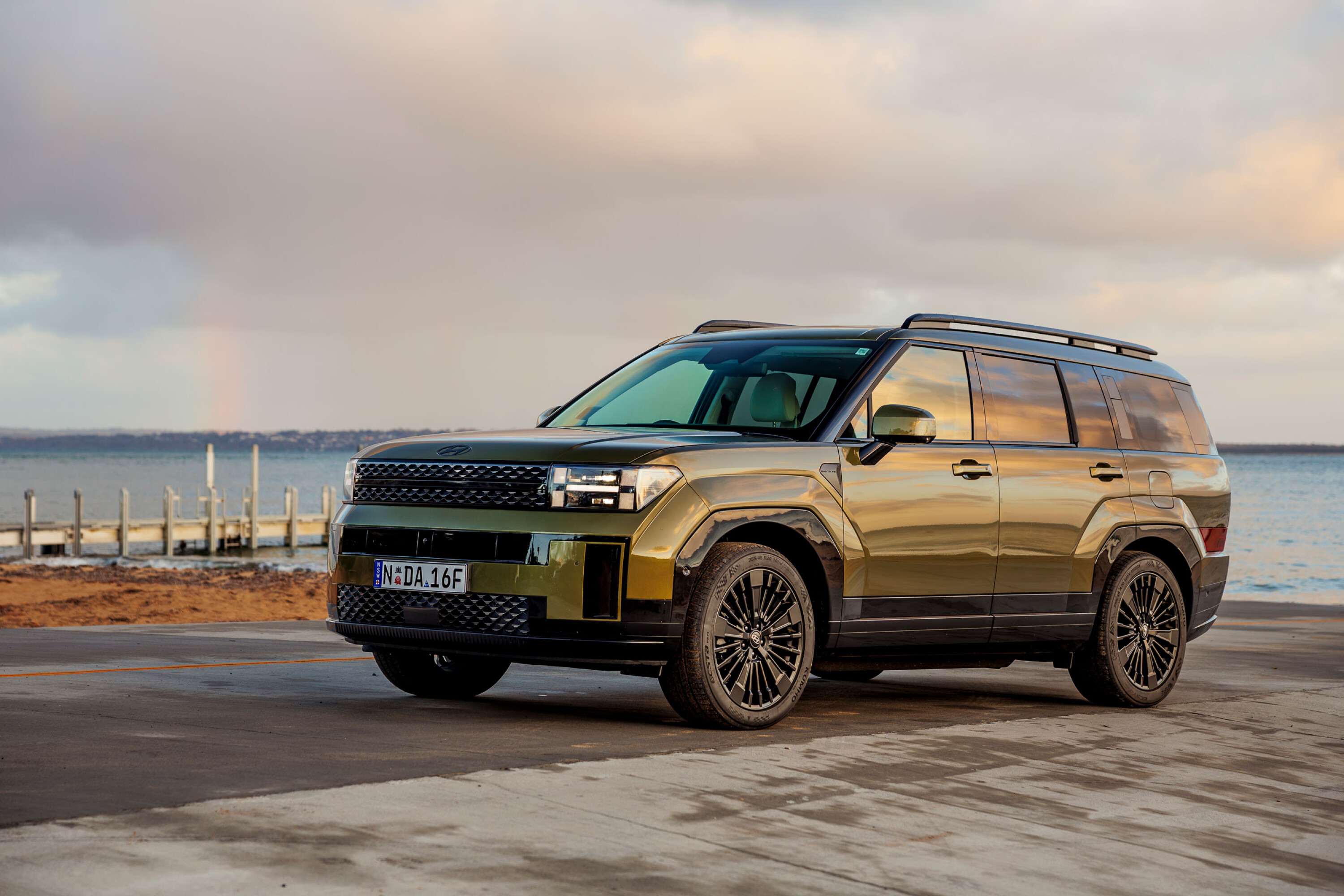
The new Santa Fe hit Australian showrooms mid-year priced $10,000 above the outgoing model, which design changes alone can’t justify. All models are powered by a hybridised 172kW/367Nm 1.6-litre turbocharged petrol engine driving either the front wheels or all four. Hyundai will add a non-hybrid 206kW 2.5-litre turbo in due course, replacing the previous generation’s 3.5-litre V6. But diesel is no longer part of the Santa Fe range.
For now, the four-cylinder hybrid is where it’s at, and despite being the smallest Santa Fe engine ever, it delivers. Even though the Santa Fe Calligraphy we tested weighs in at 2105kg, the hybrid engine and six-speed automatic transmission do a more than adequate job of meeting daily driving demands.
There is a touch of throttle lag below 2500rpm, which can make the car feel a little lethargic, most obvious in Eco mode which is prioritising fuel economy. Move out of Eco to Normal mode and the engine responds better and is also more willing to smoothly drop gears to give the driver what they want. That said, the engine can become coarse when put under pressure.
The hybrid powertrain’s energy recuperation system is commendably invisible. There’s no jerkiness transitioning from regenerative braking to recuperation. It’s also clearly doing its primary job, because we recorded 6.6L/100km on our very hilly 50km open-road loop, just one litre higher than its official claim.
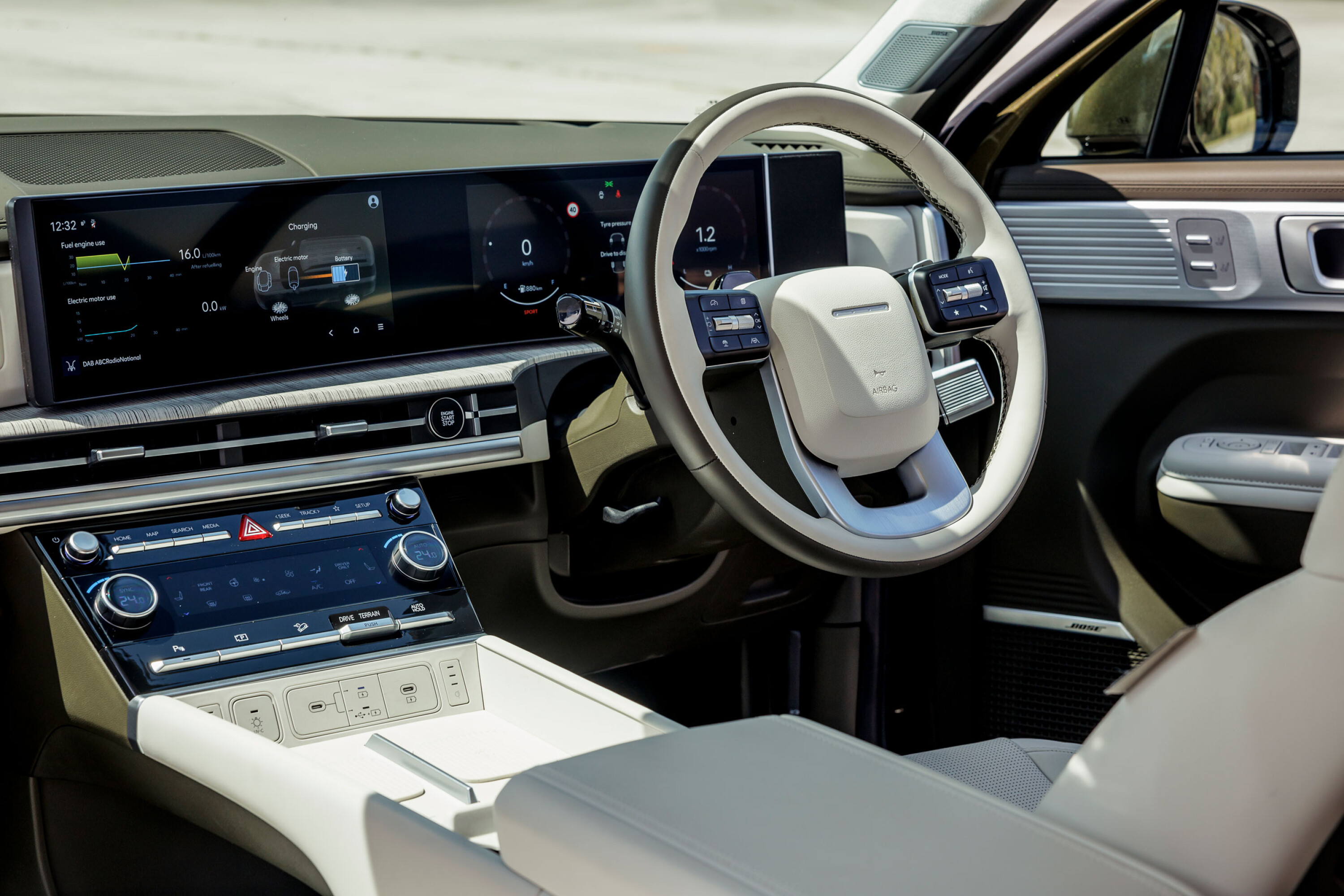
When it comes to ride quality, the Santa Fe is less impressive, but that’s more a reflection of its highly polished rivals than any real-world deficiency. The Santa Fe is another Hyundai whose suspension has not specifically been tuned for Australian conditions, the factory relying instead on historical data. This results in a vehicle that’s busier than its rivals, and also noisier on its Kumho Ecsta tyres.
The ride isn’t overly terse or overactive, just without the suppleness to match the Kluger or indeed its Kia Sorento stablemate. The tyres and suspension tune do make up for it dynamically; this may be a family truckster, but it also has the poise and the grip to make winding roads more enjoyable.
While some may debate the importance of chassis dynamics for a family SUV, Wheels sees merit in driving competence and confidence. We’d much rather a dynamically proficient family vehicle than the alternative. But still, the wider target market will be more focused on the Santa Fe’s space and practicality than any dynamic overtones.
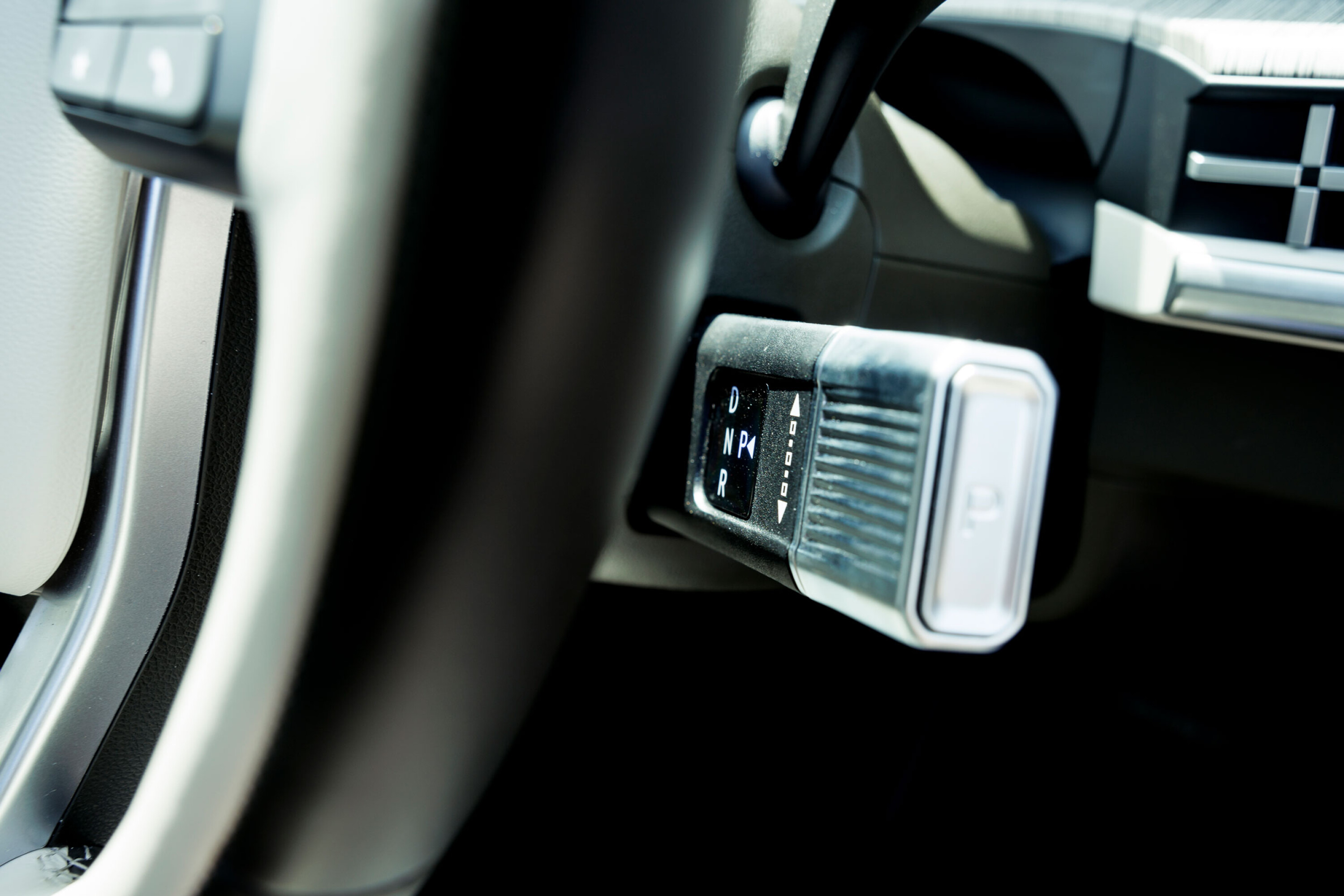
The new body is bigger: 45mm longer, 10mm taller, and riding on a 50mm-longer wheelbase, which liberates more legroom and cargo space inside. The boxy body also has some thoughtful touches, like the hidden handhold on the C-pillar which makes accessing rooftop loads easier, and also for clambering into the third row. The biggest dimensional change, however, has to be the boot opening which is 145mm wider, giving loads more load width. The boot floor’s loading height is lower, too.
The boot is a whopper in two-row mode (628 litres), but buyers will need to tick a few rooftop luggage options if they’re planning roadtrips with all three rows occupied because luggage space is almost non-existent in this configuration. Still, that’s the same for any SUV in this class, and Hyundai’s extensive – and affordable – options list again highlights the company’s family focus during development.
The range incorporates three model grades – Santa Fe, Elite and Calligraphy – and all come with three rows of seating in a 2+3+2 configuration. There’s a second Calligraphy model that replaces the bench middle row with two individual seats – handy for separating offspring that like to niggle and tease, and for walk-thru access to the third row.
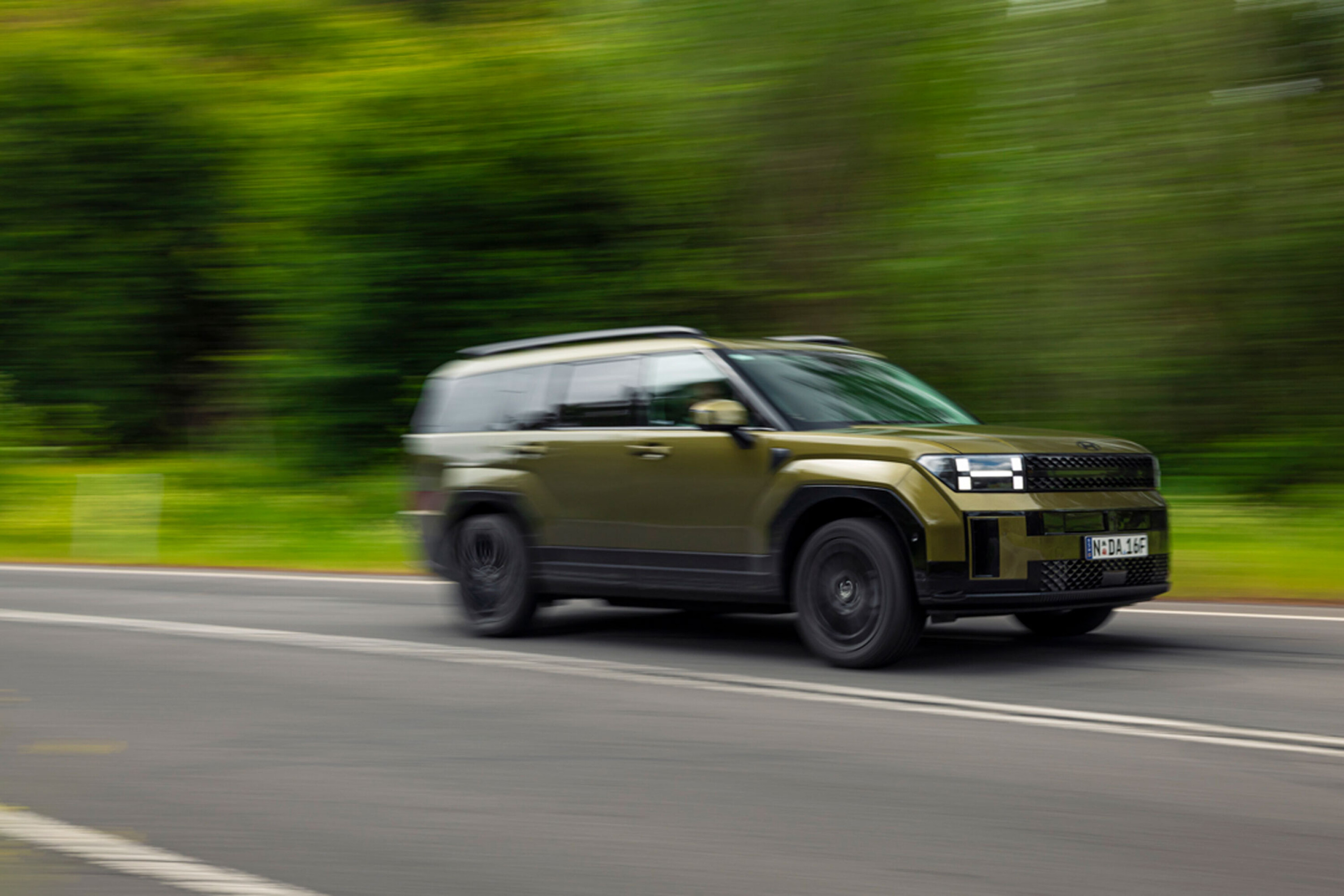
We chose to test the top-spec Calligraphy because it’s expected to outsell both the base model and the Elite combined. It puts everything on the table for buyers, but does cost $75,000 plus on-roads.
The cabin continues the boxy theme with amusing attention to detail, and also makes use of modern materials to convey quality and class. Again, Hyundai’s thoughtfulness and innovation shine through. For starters, dual wireless phone chargers speak to its family friendliness, as do the many useful storage spaces – including the centre console’s double-hinged lid that opens for rear occupants as well.
Kudos to Hyundai for also resisting the temptation to go all-in with touchscreen controls and retain actual buttons for the dual-zone climate control and other oft-used systems as well. And for adopting the one-touch speed warning override as debuted on Genesis models earlier this year, doing much to fix one of the Santa Fe’s most tedious features.
The second row has plenty of legroom and headroom, even with the Calligraphy’s huge sunroof, and the third row can accommodate adults at a push (if the second row compromises its legroom), but is more suited to children.
The more we delved into the Santa Fe, the more we understood the lengths Hyundai has gone to address buyer needs and concerns. This new Santa Fe is a thoughtfully designed and brilliantly executed family SUV that improves on the previous generation in all the right areas.
– Glenn Butler
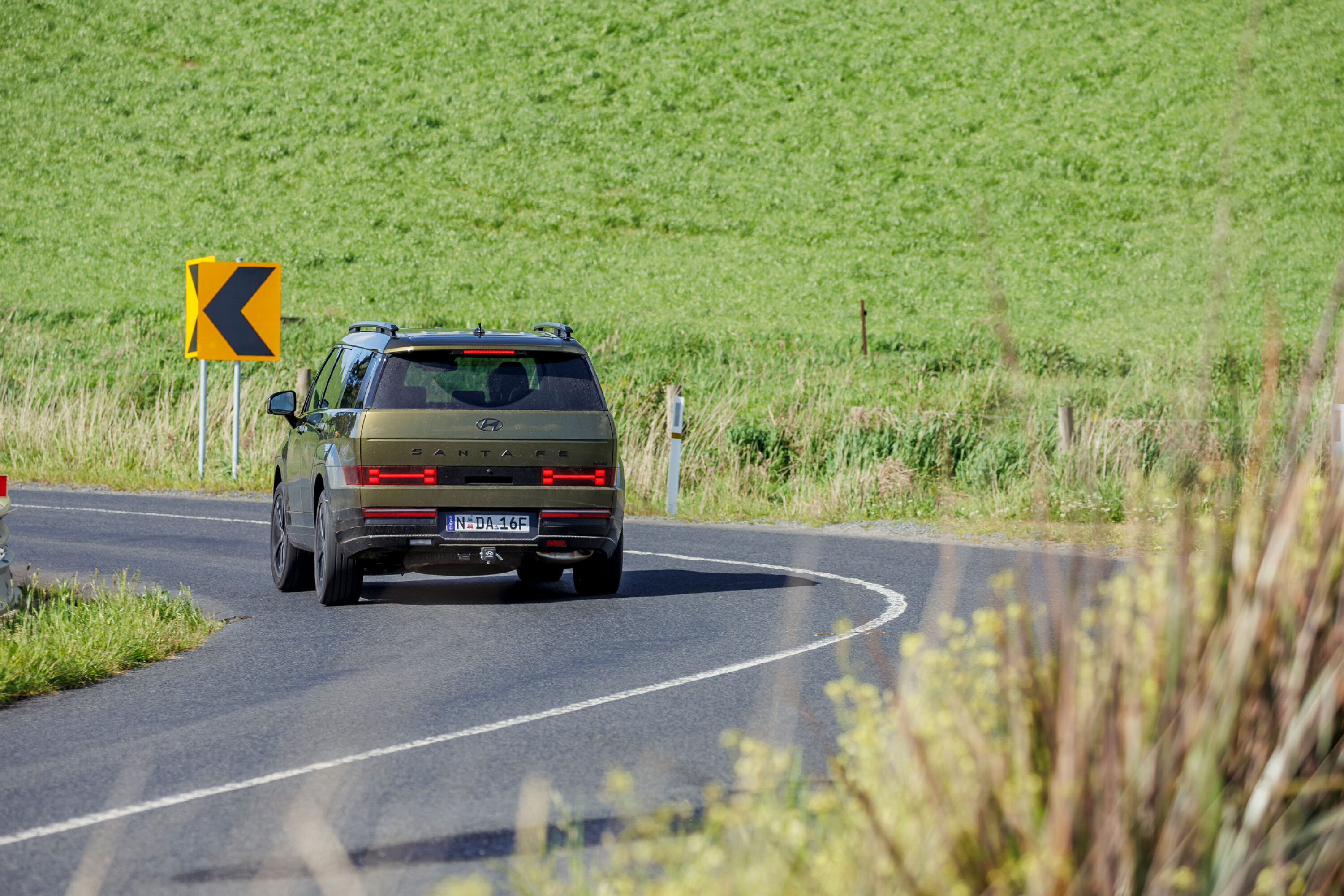
| Hyundai Santa Fe Calligraphy | |
|---|---|
| Price/as tested | $75,000/$75,990 |
| Drive | 1598cc 4cyl, dohc, 16v, turbo, hybrid |
| Power | 172kW @ 5500rpm |
| Torque | 367Nm @ 1500-4500rpm |
| Transmission | 6-speed automatic |
| Weight | 2105kg |
| L/W/H/WB | 4830/1900/1770/2815mm |
| Tyre | Kumho Ecsta PS71 255/45R20 (f/r) |
| Safety | Untested |
Hyundai IONIQ 5 N
The first EV that you’d take for a drive just for the fun of it? That’s what the IONIQ 5 N could well be. Albert Biermann and the team at Hyundai’s N Division have engineered this to be ingrained from top to bottom with laugh-out-loud enjoyment and baked-in driver engagement.
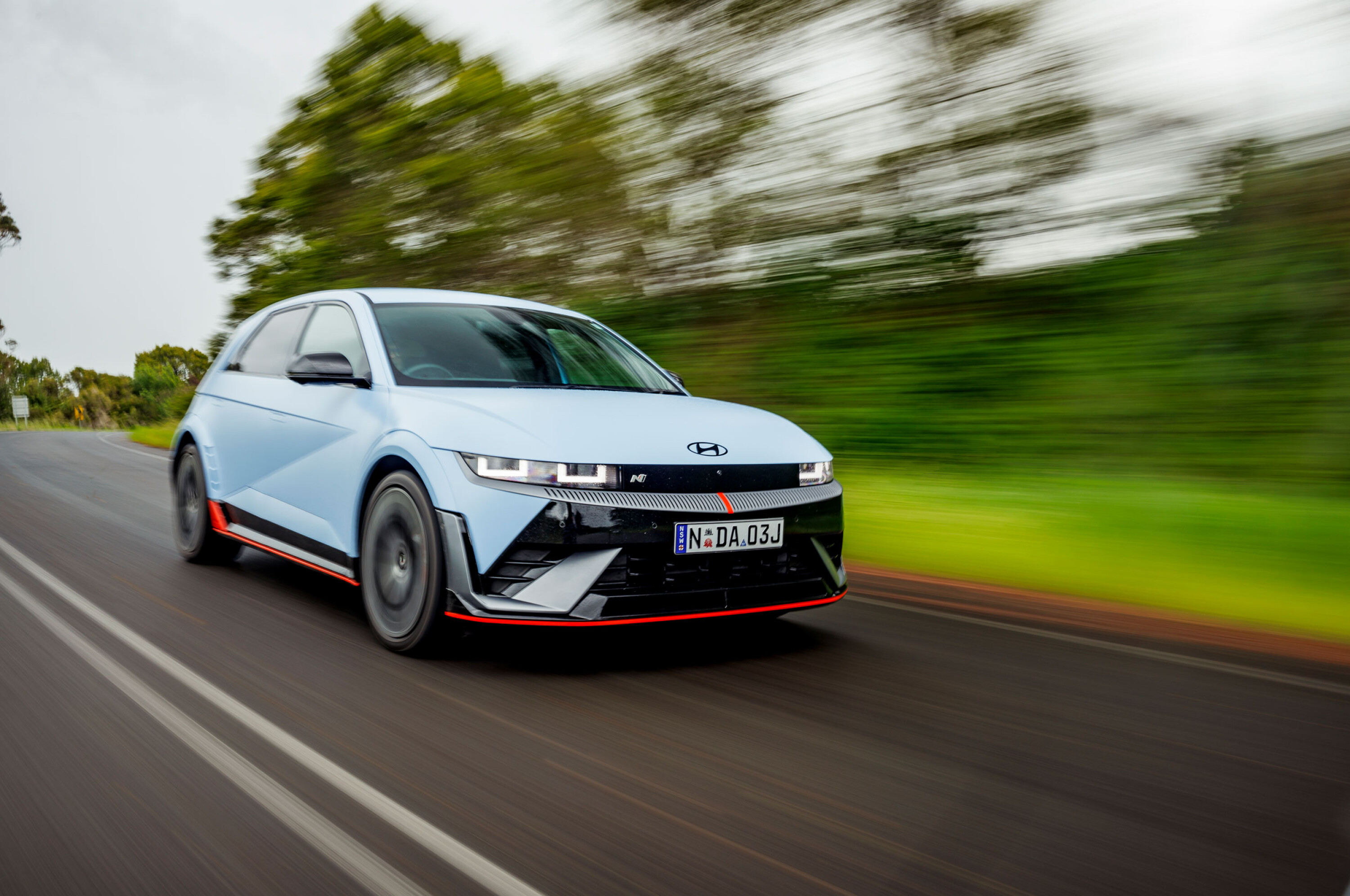
It takes a very special sort of road car to impress somebody who has won the Australian rally championship seven times, but after we ran performance tester Cody Crocker through the 5 N’s manual gear shifting system, he returned with a massive grin and a distinct reluctance to hand back the keys. “I’ve got a new favourite car,” he said. “I had no idea it could do that.”
Ah, yes, that. It was always going to be a controversial move, offering drivers the option of artificially mandated gearshifts, a rev limiter, and the feeling of torque building as the entirely non-existent engine comes on cam. At first glance, it would seem to play into the hands of those who claim that electric powertrains are lame and that the old ways are better, but do we need to be that partisan, that binary? Can we not take the best of both to create something new and incredible? That’s exactly what Albert Biermann and his team at Hyundai’s N division has done with this remarkable car.
Value? You’re getting a performance car with 478kW; comfortably more power than a McLaren F1 for $110K. Safety? The IONIQ 5 has returned a five-star ANCAP rating. Layer on top of that the bigger brakes, better tyres and additional safety systems of the 5 N and that box is resolutely ticked. Cabin design and execution? It seats five adults in comfort, has a big boot and is well-appointed throughout, with thoughtful stowage inside the car, solid ergonomics and a flat floor. How it drives? If that includes the ability to make you laugh out loud in pure joy, then nothing at this year’s event, even the fabulous Mustang Dark Horse, could top it. The mantra that ran through the 5 N’s development speaks volumes: driving still matters.
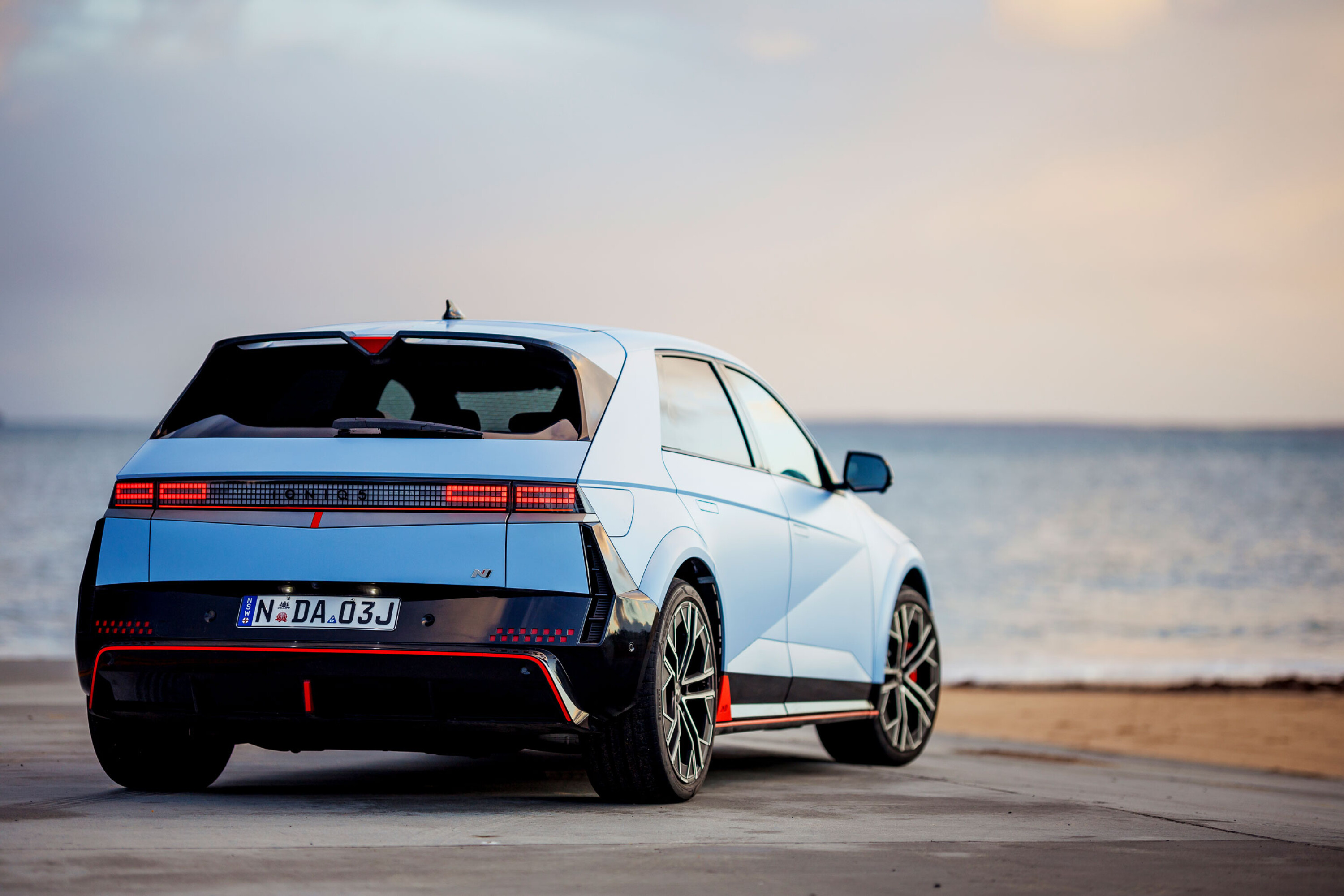
Of course, it’s not perfect. No COTY winner ever is. Drive it like you mean it and that claimed 448km WLTP-mandated range shrinks somewhat. Throw it from lock to lock around hairpins at a racetrack and the tyres will let you know that, despite its nimble feel, there’s 2230kg of physics at work here. Then there are the whispers that Hyundai is ready to unleash something even focused, and that the full-bodied IONIQ 5 was a mere toe-in-the-water platform for the Koreans in order to gauge customer reception. As ever, we can only test the cars that are put in front of us.
It resists roll well and there is so much to be said for plucking the gears yourself. At first, you’ll feel silly. Ten seconds later, you won’t give a hoot about how silly you think it is – you’ll be laughing too much. Isn’t that what we want from performance cars today: to feel connected and engaged? The IONIQ 5 N delivers that in spades. Don’t get mired in how you got there. Just enjoy the end result.
– Andy Enright
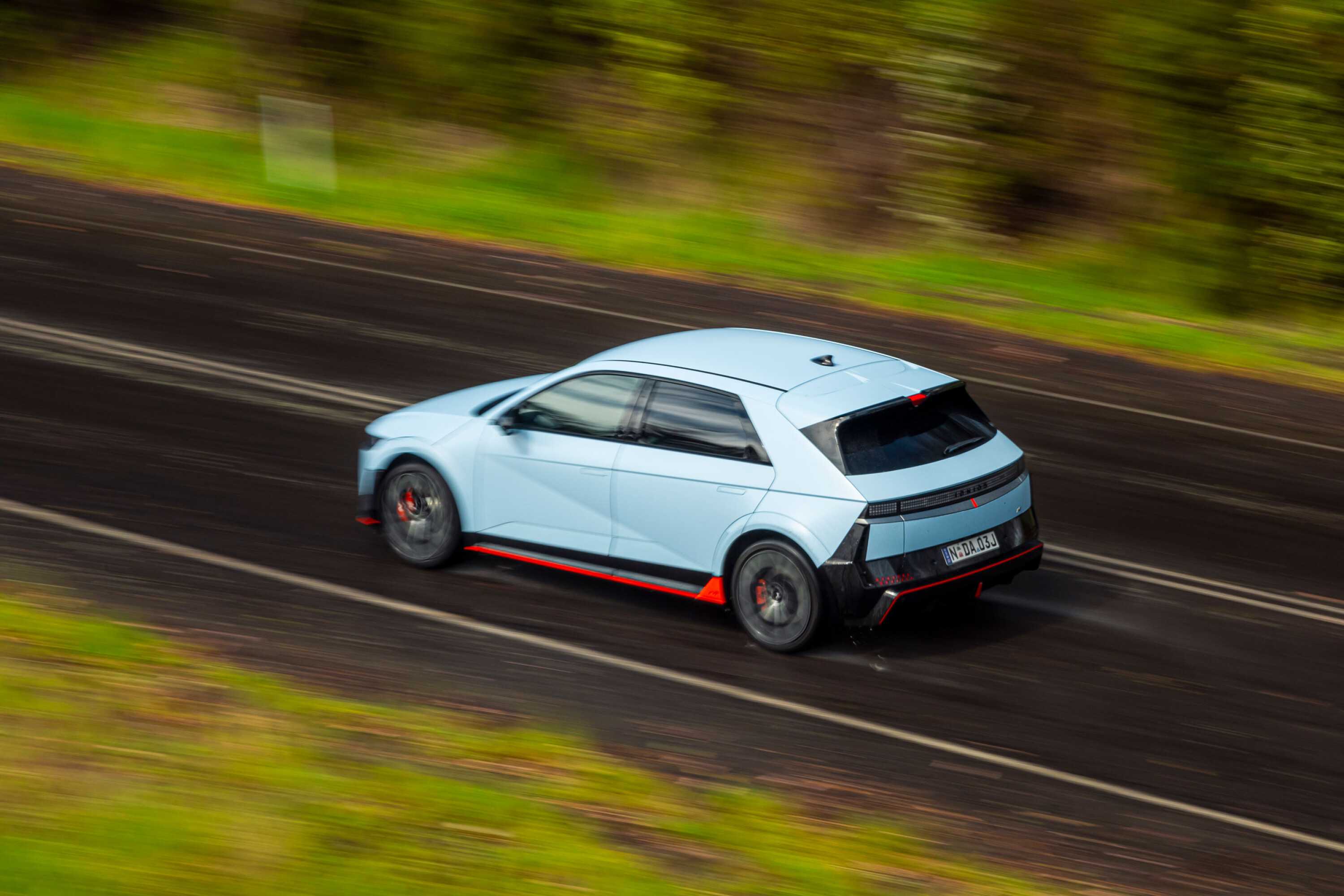
| Hyundai IONIQ 5 N | |
|---|---|
| Price/as tested | $110,383/$112,383 |
| Drive | 2 x electric motors, 84kWh lithium-ion battery |
| Power | 448kW |
| Torque | 740Nm |
| Transmission | Single-speed reduction gear |
| Weight | 2230kg |
| L/W/H/WB | 4715/1940/1585/3000mm |
| Tyre | Pirelli P Zero 275/35ZR21 (f/r) |
| Safety | Untested |
Kia EV5 Earth AWD
With the range starting at $56,770 drive-away for the base front-drive Air Standard Range, we chose the mid-spec $68,990 drive-away Earth with its larger 88.1kWh battery, 500km of claimed WLTP range, all-wheel drive and various other extra equipment. While it doesn’t quite make the same futuristic statement as the EV9 in the metal, it still looks plenty good to our eyes.
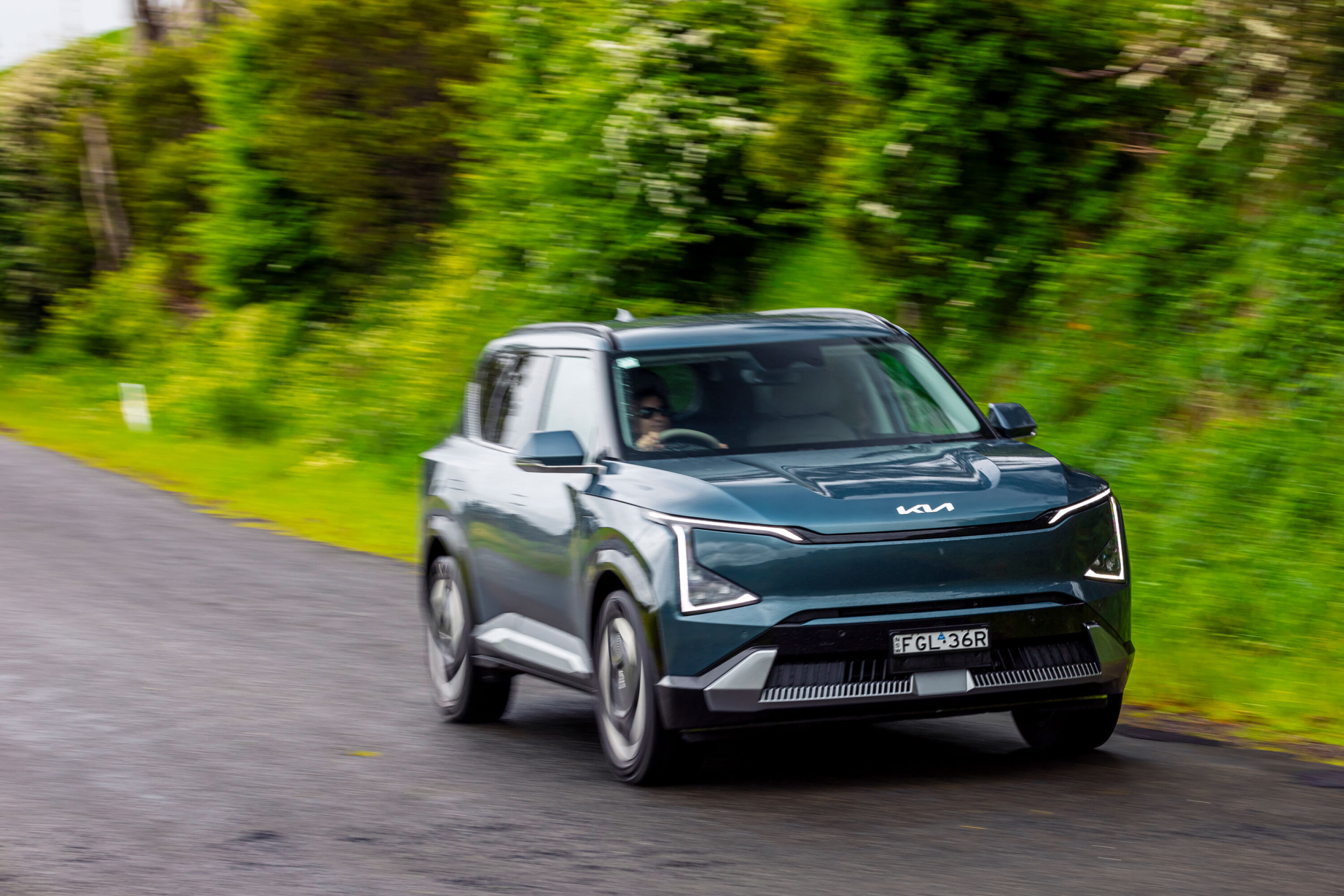
Inside, there are dual screens, a feeling of rock-solid build quality and a decent mix of materials – some premium, some a bit cheap. But on the whole, this is a pleasant place to be. Space in the back is also good, with a sliding second row, and there’s a decent 513-litre boot – no doubt helped by the lack of any spare wheel.
Back up front, there was one design feature that had the judges befuddled. Where you’d normally find the centre console, instead the EV5’s passenger seat lower cushion extends inwards almost like a faux bench. Nobody can sit on it, mind you. There’s a pocket in which to stuff things, but the consensus was a classic tale of form over function – no deal-breaker but robbing the EV5 of some crucial central storage space.
With its high seating position and tall overall proportions, the EV5 grants a curious boxy sensation when driving, as if you’re somehow in a short-wheelbase version. And it acquitted itself well enough around Lang Lang’s ride and handling circuit with accomplished EV damping, fluid handling and an absorbent ride quality.
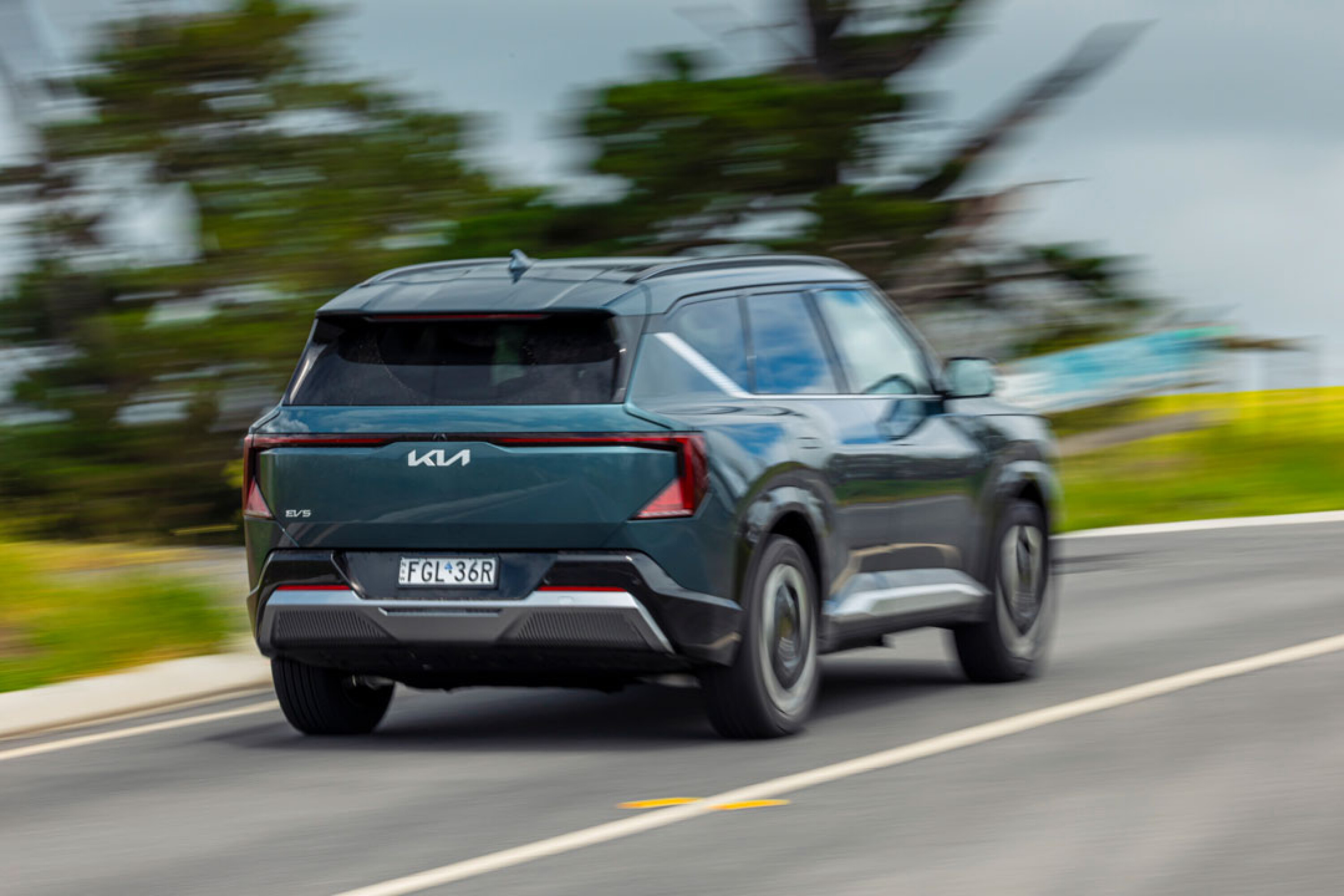
While it has two electric motors, ‘just’ 230kW and 480Nm is on offer – something actually sensible if you ask us. You get the security and added usability of all-wheel drive with acceleration more than sufficient for the people who will be buying this vehicle. Not every dual-motor EV should be able to accelerate like a last-generation Ferrari hypercar. Especially in the hands of someone just trying to duck down to their local Woolies for more bread.
Away from the proving ground and road loops of COTY testing, the EV5 is a worthy alternative to the all-conquering Tesla Model Y.
In this guise, its $68,990 drive-away price undercuts the Model Y Long Range, but with comparable range (500km claimed WLTP, versus the Tesla’s 533km), a longer warranty (seven years versus four) and a more classic, car-like interior that makes a Model Y feel featureless inside. There’s also the fact it’s not a Tesla.
– Dylan Campbell
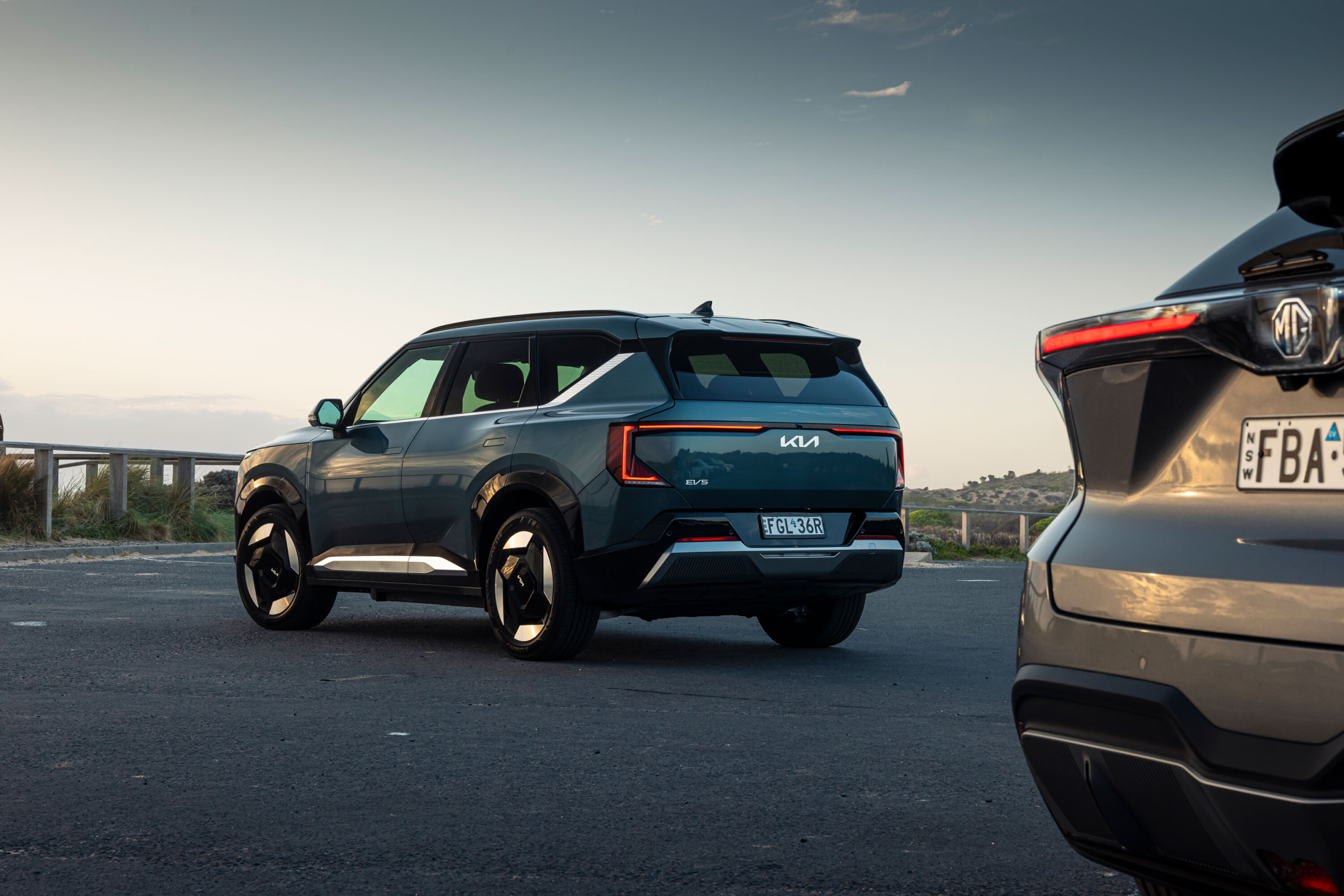
| Kia EV5 Earth AWD | |
|---|---|
| Price/as tested | $64,770/$68,990 (d/a) |
| Drive | 2 x electric motors, 88.1kWh lithium-ion phosphate battery |
| Power | 230kW |
| Torque | 480Nm |
| Transmission | Single-speed reduction gear |
| Weight | 2198kg |
| L/W/H/WB | 4615/1875/1715/2750mm |
| Tyre | Kumho Solus HS63 EV 235/35R19 |
| Safety | Untested |
MG4 Essence 64
Here is a vehicle that offers performance, practicality and peace of mind – thanks to a 10-year/unlimited-kilometre warranty – but also changes the value equation and makes buying an EV a viable option for so many people by coming to market from just $37,990.
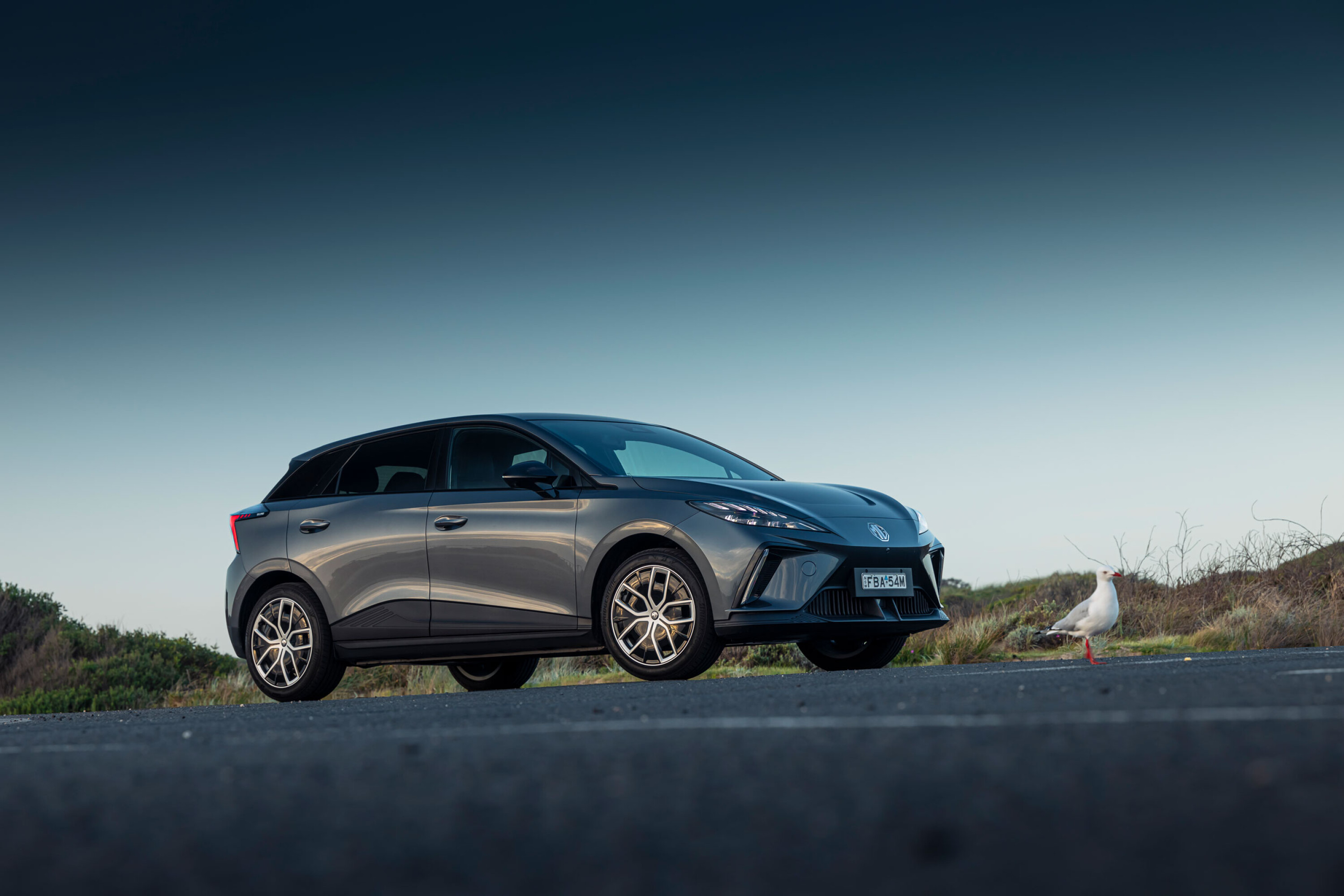
Even if this MG was only a very basic, barely pleasant thing to drive, it would be a game-changer, but in the shape of the MG4 Essence 64 model we were driving at COTY ($49,150 drive-away in Victoria), it’s a lot more than that. Indeed, even at this spec level, it’s a five-door, five-seat family hatch that makes plenty of EVs in the $60,000 to $70,000 price range look like terrible value, while also offering something to the purist with its single-motor, rear-wheel drive powertrain offering 150kW/250Nm and a 0-100km/h time of 7.2sec.
The fact is, it feels a lot faster than that and makes the most of the kind of instant-torque shove that electric vehicles are so good at delivering, particularly where you most want it in those overtaking moments between 60 and 80km/h, and 80 to 110km/h. It does lack a bit of punch above 120km/h, a problem that is resolved if you opt for a twin-motor MG4 model.
Better yet, as all of the judges noted after driving it around the ride and handling loop, the MG4 offers properly sporty turn-in, talkative steering. Having made it through to the final six of this year’s COTY, based on judges agreeing unanimously that the MG4 represents a vehicle that is a genuine game-changer and stands out from the field in terms of value in particular, as well as driver enjoyment (once you get it moving), it’s ride quality was found wanting on the testing road loop.
In terms of driving dynamics, there’s no doubt the MG4 is very good for what it is, and that it marks, as the judges agreed, a line in the sand for MG: “We don’t just make cheap cars – we make cars that are good to drive.”
– Stephen Corby
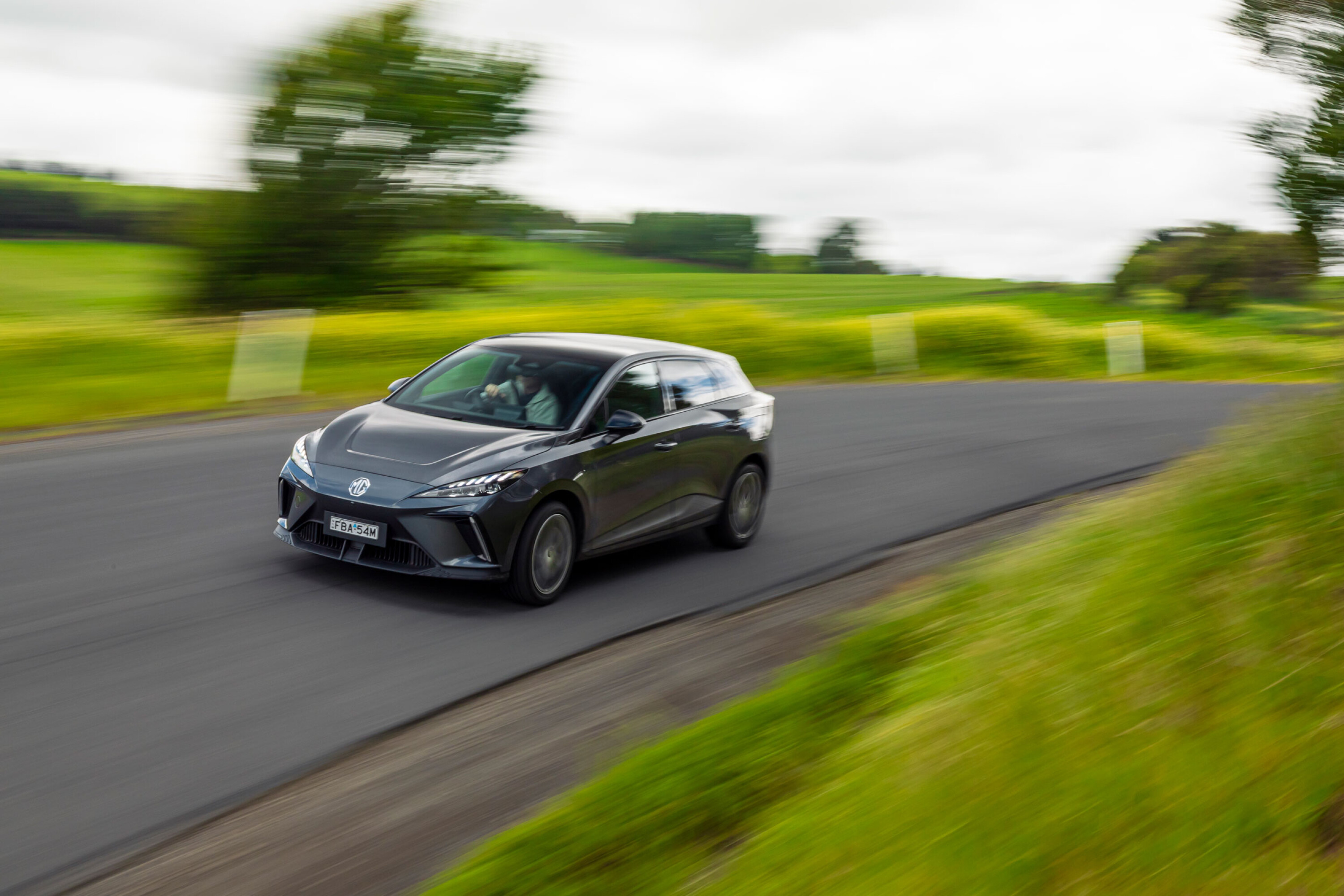
| MG4 Essence 64 | |
|---|---|
| Price/as tested | $44,990/$49,150 (d/a) |
| Drive | 1 x electric motor, 64kWh lithium-ion battery |
| Power | 150kW |
| Torque | 250Nm |
| Transmission | Single-speed reduction gear |
| Weight | 1672kg |
| L/W/H/WB | 4287/1836/1516/2705mm |
| Tyre | Bridgestone Turanza T005 235/45R18 (f/r) |
| Safety | Five stars |
Toyota Camry Ascent Sport
The reason this Toyota is Australia’s most popular sedan, our ubiquitous taxi, and is now employed by more ride-share drivers than any other vehicle, is easy to understand. No potential rival goes close to matching the Camry’s long-acknowledged low operating costs, reliability, and practicality.
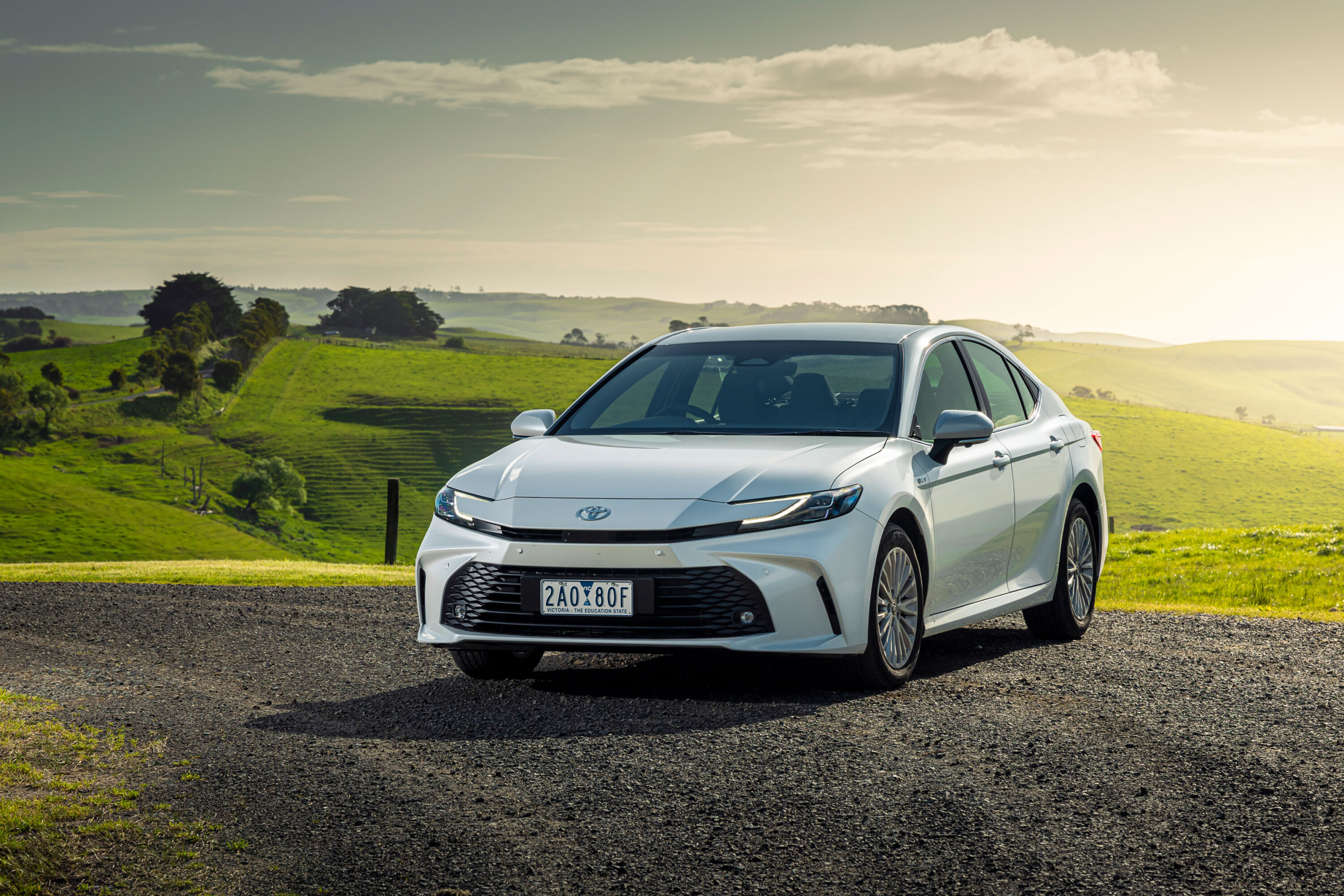
With the coming of the latest generation, the list of virtues grows to include true refinement, spacious comfort and, now it’s hybrid-only, extremely thrifty fuel economy plus, most surprisingly, driving pleasure.
Today’s ninth-generation XV80 Camry is a worthy evolution of the previous XV70 model – the first based on Toyota’s TNGA-K platform (RAV4 and Kluger), and the Camry that lifted the dynamics and refinement above the mediocre XV50 that ran until 2018.
The new Camry is the latest evidence of a quarter of a century spent perfecting hybrid technology, and it shows. Driving it is to experience a wonderful powertrain, whose low-end EV-like performance gets you effortlessly around town. Quick and smooth, the experience feels more creamy and contemporary than ever. On the highway, more throttle is required to overtake but it’s so effortless that the erstwhile V6 is never missed. All this while delivery outstanding – think circa 4.0L/100km or less – economy, though admittedly the 2.5-litre DOHC four does need 95RON premium fuel. There’s no talk of a plug-in hybrid.
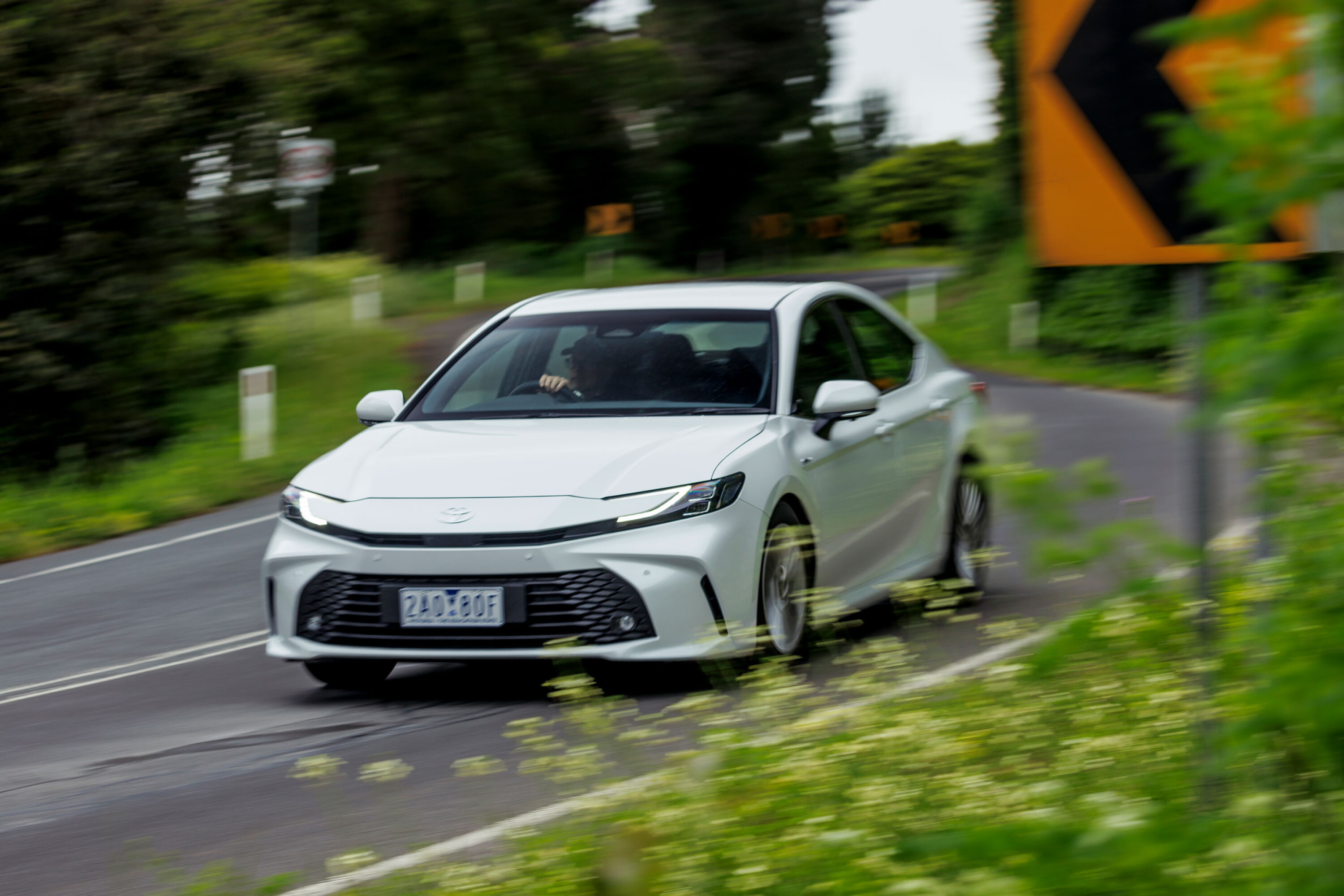
In as-tested Ascent Sport guise, and despite its conservative, evolutionary styling (the front doors and roof are carried over from the previous model), this is the sportiest Camry we’ve ever driven, as well as being the most comfortable. Subtle suspension and steering modifications (the power steering is now speed sensitive) and a reinforced structure mean this brilliant combination of qualities begins with quick, confidence-inspiring steering, relaxed yet stable and composed road manners, and surefooted braking via a short-travel pedal feel that is easy to modulate. Responsive handling, with just a touch of understeer, provides the Camry with the ability to be punted quickly and effortlessly on challenging roads. Yes, it’s true – here’s a Camry that is fun (perhaps pleasurable is more accurate) to drive.
The three-tiered model line-up (the SX has been dropped) includes Ascent and Ascent Sport, clustered closely together on price and equipment. The top-of-the-range SL jumps both in price and equipment. The Camry Ascent, starting from $39,990 plus on-road costs, includes 17-inch alloy wheels, LED headlights and running lights, a urethane steering wheel, keyless entry and start, dual-zone climate control, a 7.0-inch infotainment screen, six-speaker audio, and 7.0-inch driver’s display plus 360-degree cameras.
Our $42,990 Ascent Sport gains high-grade LED headlights and LED fog lights, a powered driver’s seat with adjustable lumbar support, leather-wrapped wheel, and a wireless phone charger. The monitor steps up to a 12.3-inch display and all systems are equipped with wireless CarPlay and Android Auto, AM/FM/DAB+ radio, Bluetooth connectivity, and navigation.
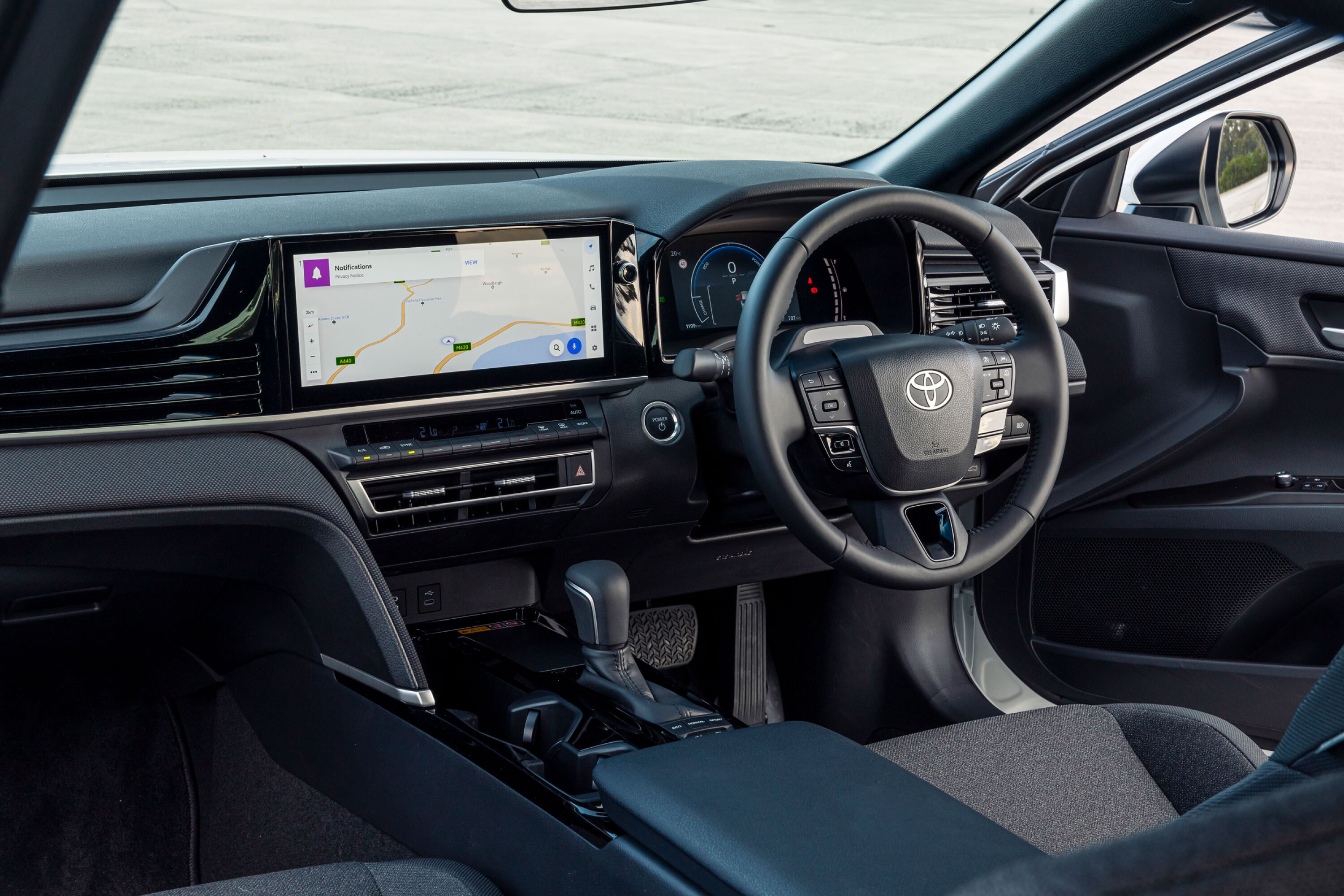
The flagship Camry SL kicks off from $53,990 and gets a much longer list of standard features including 18-inch alloy wheels, a panoramic sunroof, leather seat trim (we prefer the cloth), a power-adjustable passenger seat, powered steering column and driver’s memory function, heated and ventilated front seats, heated steering wheel, 12.3-inch digital instrument display, digital rear-view mirror, rain-sensing wipers, a head-up instrument display, and a nine-speaker JBL sound system.
The spacious cabin allows a tall passenger to sit behind an equally tall driver, while the front seats deliver plenty of lateral support, a further encouragement to driving this Camry hard. Sensibly, there are plenty of buttons for the important controls and the 7.0-inch digital instrument display is terrific, with legibility much improved over the previous model. The boot is vast and supplemented by 60/40 split folding seats. A rear parking camera is standard.
All Camrys come with a standard suite of driver-assistance features that includes automated emergency braking with pedestrian and cyclist detection and automatic high-beam headlamps, active cruise control, and a feature that helps the driver prepare for curves by gently applying the brakes.
– Peter Robinson
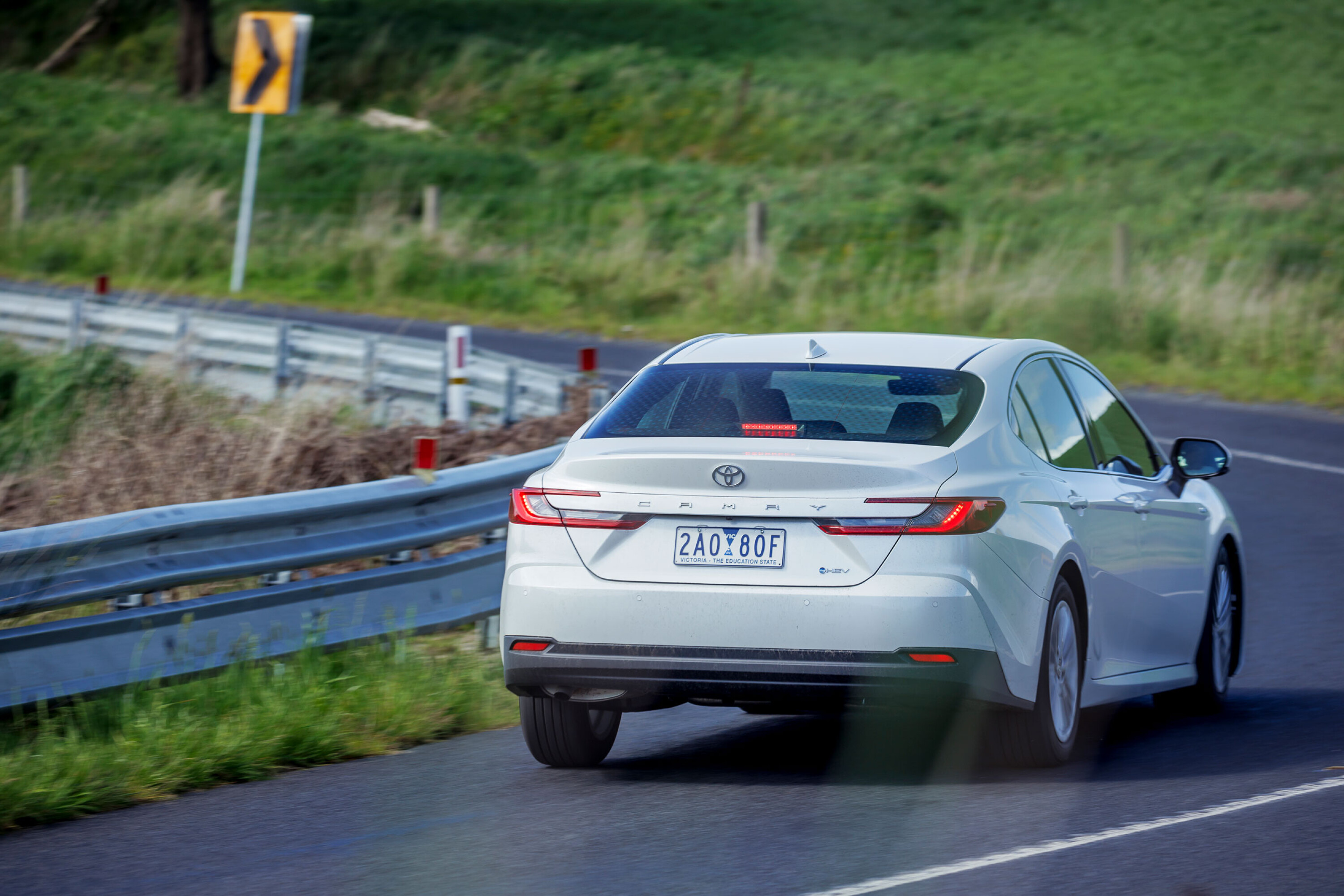
| Toyota Camry Ascent Sport | |
|---|---|
| Price | $42,990 |
| Engine | 2487cc 4cyl, dohc, 16v, hybrid |
| Power | 170kW (combined) |
| Torque | 221Nm @ 3600-5200rpm |
| Transmission | CVT |
| Weight | 1565kg |
| L/W/H/WB | 4920/1840/1445/2825mm |
| Tyre | Yokohama BluEarth GT 215/55R17 (f/r) |
| Safety | Five stars |

